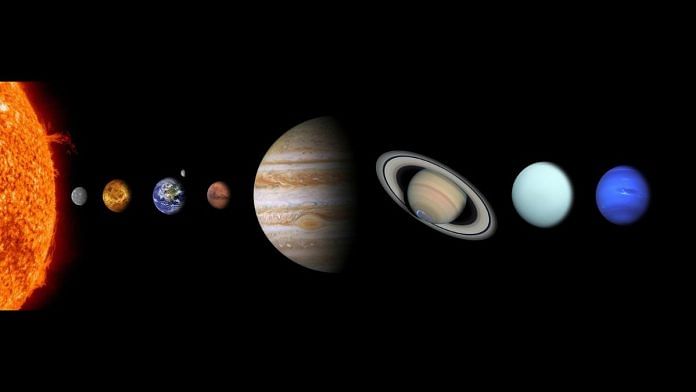New Delhi: A rare celestial event will adorn the night skies of India through early March, starting 21 January. Seven planets will line up for a ‘planetary parade’, some of which will be visible to the naked eye.
The planetary parade, also known as a planetary alignment, will begin with only four planets—Venus, Saturn, Jupiter, and Mars.
By mid-February, the remaining planets—Mercury, Neptune, and Uranus—will also join the parade, making it a visual treat for amateur astronomers and stargazers.
ThePrint explains the phenomenon, how rare it is, and the ideal time to catch this celestial spectacle.
Also Read: 2024 Physics Nobel for AI scientists. How they pioneered machine learning modelled on human brain
What is a planetary parade
A planetary parade is a phenomenon where multiple planets appear to line up in the night sky to the Earth’s observers.
While it is not rare for multiple planets to be spotted in the sky at the same time, a period when all seven planets are visible has piqued the interest of stargazers around the world.
The last time such a rare event occurred was in 2022.
Virendra Yadav from the Aryabhatta Research Institute of Observational Sciences (ARIES), who is also the co-chair of the public outreach and education committee of the Astronomical Society of India, told ThePrint that in the first half of the planetary conjunction—when two or more planets appear close together—Venus, Saturn, Jupiter, and Mars will be visible. As the weeks progress, Mercury will join the parade and, by the end of February, Neptune and Uranus will also be seen in the night sky.
The clearest view of the celestial event will be on 21 January and 28 February.
“The exciting part of this parade is that most of these planets will be visible to the naked eye. You might need a telescope to view Neptune and Uranus,” Yadav explained.
Why it is rare
Astronomers say that an alignment occurs on the ecliptic—an imaginary plane that directs the Earth’s orbit and the orbit of other planets around the Sun.
All seven planets stay on this plane while moving at different speeds. Since each planet is at a different distance from the Sun, its orbital speed varies.
The farther the planet is from the Sun, the longer it takes to complete one revolution.
The rarity of the planetary alignment comes from the fact that it is easier for a few planets to align when they cross paths during revolution, but for all of these to align is a rare event.
It is also important to note that as planets move through the ecliptic, they might eventually align, but they will never form a perfectly straight line. This is because each planet has a slight deviation in its location relative to the ecliptic, and their orbits are tilted at varying degrees relative to the plane.
The National Aeronautics and Space Administration (NASA) has also urged people to keep an eye out on the skies to witness the event.
“Each evening this month, enjoy a sweeping view of four bright planets at once. Also, look for a close approach of Venus and Saturn, Mars occulted by the Moon, and meteors,” NASA’s public engagement specialist Preston Dyches said in a blog post on the website.
(Edited by Radifah Kabir)






